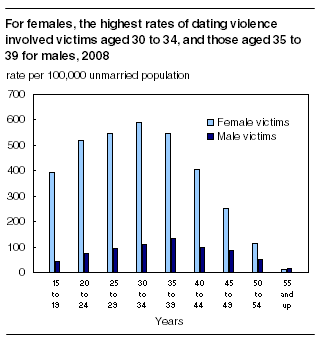Common menu bar links
Study: Police-reported dating violence
Archived Content
Information identified as archived is provided for reference, research or recordkeeping purposes. It is not subject to the Government of Canada Web Standards and has not been altered or updated since it was archived. Please "contact us" to request a format other than those available.
Related subjects
In 2008, nearly 23,000 incidents of "dating violence" were reported to police. These incidents accounted for more than one-quarter (28%) of police-reported violent incidents perpetrated by intimate partners. Dating violence represented 7% of total violent crimes in Canada in 2008.
Between 2004 and 2008, rates of police-reported dating violence increased steadily for both women (+40%) and men (+47%).
For the purposes of this study, dating violence involved violent incidents reported by police that were committed by a current boyfriend or girlfriend, an ex-boyfriend or girlfriend, or by a person with whom the victim had an intimate but non-spousal relationship. These people were not living together.
Victims of dating violence most often women
Overall, women accounted for 8 in 10 dating violence victims known to police in 2008. The majority of incidents of dating violence occurred once the relationship had ended. About 57% of incidents coming to the attention of police were committed by a former partner.
Rates of dating violence highest for those in their thirties
Among female victims, the highest rate of dating violence involved women between 30 and 34 years of age. For men, the rate was highest among those between the ages of 35 to 39.

Among teenagers 15 to 19, the police-reported rate of dating violence experienced by females was 10 times higher than the rate for their male counterparts. Adolescent victims of police-reported dating violence were most often victimized by a suspect who was older.
Note to readers
The Criminal Code does not have specific offences pertaining to dating violence. However, the Incident based Uniform Crime Reporting Survey and the Homicide Survey collect annual data on incidents of violence that were reported to police as well as detailed information about their victims and offenders. Using both of these data sources, it is possible to examine incidents of violence perpetrated by dating partners by identifying the relationship between the victim and the accused. In this study, violence includes physical violence (such as homicide, assault, sexual assault, threats) as well as harassment.
Current or former boyfriends/girlfriends as defined in the Incident based Uniform Crime Reporting Survey include both opposite and same-sex relationships.
About 10% of male victims and 1% of female victims of dating violence involved same-sex dating relationships.
Victims of dating violence most often experience common assault
Common assault, the form of assault resulting in the least physical injury to victims, was the most frequent type of violent offence committed in dating violence incidents. It accounted for half of all violent police-reported incidents by dating partners. Criminal harassment, uttering threats and indecent or harassing phone calls were more likely to occur in dating violence incidents compared with incidents of spousal violence.
According to police-reported data, 71% of incidents involving dating violence against female victims resulted in police charges, compared with 57% against male victims. These gender-based differences in charging were most pronounced among teenage victims, aged 15 to 19.
This study likely represents only a portion of incidents of violence committed in dating relationships. Data from the 2004 General Social Survey on victimization found that many victims of violence do not report the abuse to police.
Definitions, data sources and methods: survey numbers, including related surveys, 3302 and 3315.
The Juristat article "Police-reported dating violence in Canada, 2008", Vol. 30, no. 2 (85-002-X, free), is now available. From the Key resource module of our website under Publications, choose All subjects, then Crime and Justice, and Juristat.
For more information, or to enquire about the concepts, methods or data quality of this release, contact Client Services (toll-free 1-800-387-2231; 613-951-9023), Canadian Centre for Justice Statistics.
Table 1
| Offence type | Total | Sex of victim | ||||
|---|---|---|---|---|---|---|
| Female | Male | |||||
| number | % | number | % | number | % | |
| Homicide/attempts | 14 | 0 | 10 | 0 | 4 | 0 |
| Sexual assault | 648 | 3 | 638 | 3 | 10 | 0 |
| Major assault (levels 2 and 3) | 2,415 | 11 | 1,742 | 9 | 673 | 17 |
| Common assault (level 1) | 11,438 | 50 | 9,301 | 50 | 2,137 | 53 |
| Forcible confinement and related offences | 735 | 3 | 719 | 4 | 16 | 0 |
| Criminal harassment | 3,235 | 14 | 2,830 | 15 | 405 | 10 |
| Uttering threats | 2,669 | 12 | 2,263 | 12 | 406 | 10 |
| Indecent or harassing phone calls | 1,354 | 6 | 1,003 | 5 | 351 | 9 |
| Other violent offences | 290 | 1 | 239 | 1 | 51 | 1 |
| Total offences | 22,798 | 100 | 18,745 | 100 | 4,053 | 100 |

